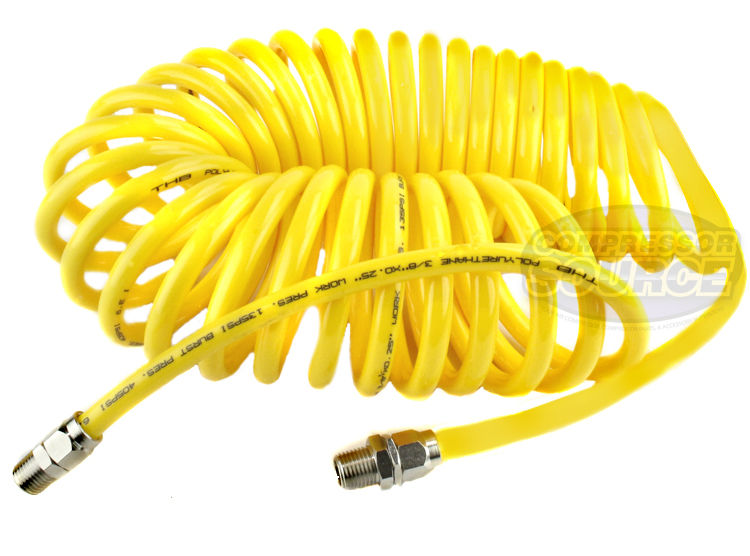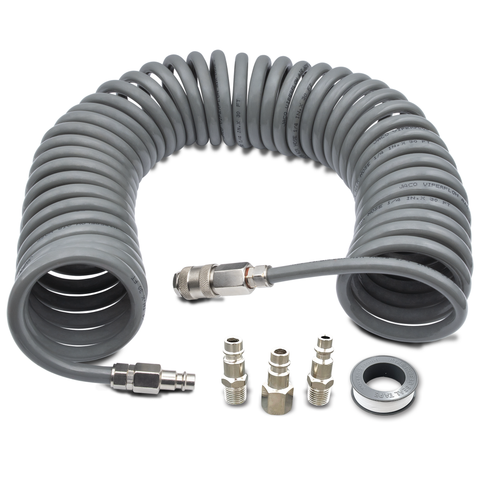If you use an air compressor regularly, you know how important it is to have the right hose. A coiled air hose for your compressor can make your work easier, safer, and more efficient.
Imagine a hose that stretches when you need it and snaps back neatly when you don’t. No more tangled messes or tripping hazards in your workspace. You’ll discover why choosing the right coiled air hose can save you time and frustration.
Keep reading to find out how this simple tool can boost your productivity and protect your equipment.

Credit: compressor-source.com
Benefits Of Coiled Air Hoses
Coiled air hoses offer many benefits for compressor users. They improve work efficiency and make tasks easier. These hoses are designed to fit small spaces and handle tough jobs. Their unique shape helps avoid common problems with regular hoses.
Using a coiled air hose means less hassle and more comfort. It stays organized and ready to use. The design also protects the hose from damage. This keeps the air flowing smoothly and safely.
Space-saving Design
Coiled air hoses take up much less space. The spiral shape keeps the hose compact. It stretches only when needed and returns to its shape. This design helps keep your workspace neat and tidy. Small storage areas benefit the most from this hose style.
Enhanced Flexibility
These hoses bend and twist with ease. They move freely without kinking or breaking. This flexibility allows better control during work. Users can reach tight spots without struggling. The hose adjusts quickly to different tasks.
Reduced Tangling
The coiled form prevents knots and tangles. It stays smooth and easy to manage. No more wasted time untangling hoses. This feature saves frustration and improves safety. A tangle-free hose lasts longer and works better.
Materials And Construction
The materials and construction of a coiled air hose for compressors play a vital role in its performance. These hoses must handle pressure, resist wear, and stay flexible. Understanding what they are made of helps in choosing the right hose for your needs.
Common Hose Materials
Coiled air hoses often use materials like polyurethane, PVC, and rubber. Polyurethane is light and flexible, great for easy handling. PVC hoses are affordable and resist chemicals well. Rubber hoses are strong and work well in tough conditions.
Reinforcement Techniques
Hoses get stronger with layers of reinforcement inside. Nylon or polyester fibers are woven into the hose walls. This helps the hose resist kinks and bursts. Some hoses have spiral reinforcements to keep their coiled shape.
Impact On Durability
The materials and reinforcements affect how long a hose lasts. Stronger hoses resist cracks and damage from bending. Flexible materials reduce wear from constant movement. Durable hoses save money by needing fewer replacements.
Choosing The Right Size
Choosing the right size for your coiled air hose is important for efficient work. The size affects air pressure, hose handling, and tool performance. Picking the correct length, diameter, and compatibility can save time and effort. Below are key points to help you choose the right size for your needs.
Length Considerations
Choose a hose length that fits your workspace. Too short limits movement and slows work. Too long adds weight and can tangle easily. Think about how far you need to reach from your compressor. Measure the distance before buying. A proper length helps keep your work smooth and safe.
Diameter And Airflow
The diameter of the hose affects airflow and pressure. A larger diameter lets more air pass through. This means better performance for air tools. Smaller diameters may cause pressure drops. Match the diameter to your tool’s air needs. This keeps tools running at their best.
Compatibility With Compressors
Check if the hose fits your compressor’s outlet. Different compressors need different fittings. Use the right connectors to avoid leaks. The hose must handle your compressor’s air pressure. Using a hose not made for your compressor can cause damage or failure.

Credit: jacosuperiorproducts.com
Maintenance Tips
Proper care extends the life of your coiled air hose for compressors. Regular maintenance keeps the hose safe and efficient. Neglect can cause damage and reduce performance.
Proper Storage
Store the coiled air hose in a dry, cool place. Avoid direct sunlight or extreme heat. Keep it away from sharp objects or heavy tools. Coil the hose gently to prevent kinks and tangles. Use hooks or reels designed for air hoses to hang it properly.
Cleaning Procedures
Clean the hose regularly to remove dirt and debris. Use a soft cloth with mild soap and water. Avoid harsh chemicals that can damage the hose material. Rinse thoroughly and let it dry completely before storing. Clean fittings to ensure a tight seal and prevent leaks.
Inspecting For Wear
Check the hose often for cracks, cuts, or holes. Look for signs of wear near the fittings and coil ends. Replace the hose if you find damage that affects air flow. Inspect connections to ensure they are tight and secure. Early detection prevents accidents and costly repairs.
Common Applications
Coiled air hoses for compressors are versatile tools. They suit many tasks across different fields. Their flexibility and durability make them ideal for various jobs. Below are common places where these hoses perform well.
Automotive Work
Coiled air hoses are popular in car repair shops. Mechanics use them to power air tools like impact wrenches and spray guns. The hose’s coil shape prevents tangling. It helps keep the workspace safe and tidy. Quick connections speed up the work on tires and engines.
Construction Sites
Construction workers rely on coiled air hoses daily. They connect compressors to nail guns, drills, and sanders. The hose’s stretch and recoil make moving around easy. It reduces tripping hazards on busy sites. Tough materials resist wear from rough surfaces and weather.
Home Workshops
Home hobbyists find coiled air hoses very useful. These hoses fit small compressors for painting or inflating tires. Their compact design saves space in crowded workshops. Users enjoy easy storage and fast tool changes. It helps complete projects smoothly without hassle.

Credit: www.amazon.com
Safety Precautions
Using a coiled air hose for a compressor needs care and attention. Safety is very important to stop accidents and keep tools working well. Follow simple rules to use the hose safely and avoid damage.
Pressure Limits
Check the hose’s pressure rating before use. Never go above the maximum pressure. High pressure can cause the hose to burst. Always use a pressure regulator to keep pressure safe. This protects both you and the equipment.
Avoiding Kinks And Damage
Do not bend the hose sharply or twist it. Kinks can weaken the hose and cause leaks. Store the hose properly by coiling it loosely. Keep it away from sharp edges and hot surfaces. Regularly inspect the hose for cracks or wear.
Handling And Usage
Hold the hose firmly during use. Do not pull it too hard or drag it across rough floors. Disconnect the hose carefully from the compressor to avoid sudden bursts. Wear safety glasses to protect your eyes. Always keep the work area clean and free of obstacles.
Comparing Coiled And Straight Hoses
Choosing the right hose for your air compressor matters a lot. Coiled and straight hoses both serve to deliver air but differ in many ways. Understanding these differences helps in picking the best option for your needs.
Flexibility Differences
Coiled hoses stretch and retract easily. They keep their shape and avoid tangles. Straight hoses are less flexible but can reach farther distances. They do not recoil, so they need space to lie flat. Coiled hoses suit tight spaces. Straight hoses work well in open areas.
Durability Factors
Straight hoses often last longer under rough use. They resist kinks and cracks better over time. Coiled hoses may wear faster if stretched too much. Their coils can weaken after heavy use. Both types need proper care to stay strong. Material quality also affects hose life.
Use Case Scenarios
Coiled hoses fit small workshops and quick tasks. They keep work areas tidy by retracting automatically. Straight hoses suit long-distance jobs and outdoor work. They allow free movement without pulling. Choose coiled hoses for light, indoor use. Pick straight hoses for heavy-duty, wide spaces.
Frequently Asked Questions
What Is A Coiled Air Hose For Compressor?
A coiled air hose is a flexible, spiral-shaped hose used with compressors. It saves space and prevents tangling during use. It offers easy storage and quick extension when needed. Ideal for workshops and garages, it enhances efficiency and convenience.
How Does A Coiled Air Hose Benefit Air Compressor Use?
Coiled air hoses improve mobility and reduce tripping hazards. Their compact design prevents kinks and tangles. They allow quick connection and disconnection, saving time. This leads to smoother operations and longer hose lifespan.
What Materials Are Used In Coiled Air Hoses?
Coiled air hoses are commonly made from polyurethane, PVC, or rubber. Polyurethane offers excellent flexibility and durability. PVC is lightweight and cost-effective. Rubber hoses provide strength and resistance to abrasion and chemicals.
Can Coiled Air Hoses Handle High Pressure?
Yes, many coiled air hoses are designed to withstand high pressure. Always check the hose’s PSI rating before use. Using a hose beyond its pressure limit can cause damage or accidents. Proper selection ensures safety and performance.
Conclusion
A coiled air hose keeps your workspace neat and safe. It stretches easily and recoils quickly after use. This type of hose saves space and avoids tangles. It works well with most air compressors. Choosing the right hose helps your tools perform better.
Regular care keeps the hose strong and lasting longer. Simple, flexible, and reliable—these hoses make work easier. Consider one for your compressor setup today.

